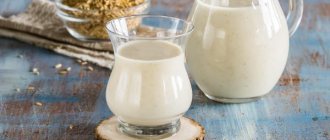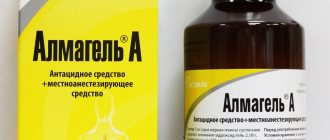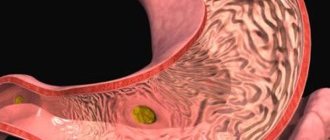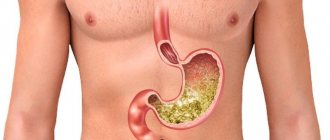Maalox is used to reduce the acidity of gastric contents. Medicinal substances neutralize hydrochloric acid and relieve symptoms associated with the entry of stomach contents into the esophagus, throat, and oral cavity. It is used in the symptomatic treatment of GERD, gastritis and other pathologies.
Combination antacid medications are good for relieving heartburn. The substances normalize the acid-base state in the stomach and prevent acid damage to the esophagus. Symptoms such as pain in the chest, sour belching, and heaviness in the abdomen disappear. Not suitable for permanently reducing stomach acid levels.
Composition and release form
All forms of the drug contain magnesium oxide and aqueous aluminum oxide monohydrate as active components. The dose depends on the dosage form. There are additional chemical compounds that facilitate the absorption of active substances.
Produced in the form of suspension and tablets.
Maalox in the form of a suspension
Liquid dosage form for oral administration. The content of active components depends on the specific form of release. Sold in bags and containers.
Content of active and additional substances:
- One hundred milliliters of suspension in a container : four grams of gel-like magnesium hydroxide and three and a half grams of gel-like aluminum hydroxide. Additional substances: ten percent hydrochloric acid, citric acid, saccharin, water, domiphene bromide, sorbitol, mannitol, hydrogen peroxide, mint leaf oil.
- Fifteen milliliter sachet of suspension : six hundred milligrams of gel-like magnesium hydroxide and five hundred and twenty-five milligrams of gel-like aluminum hydroxide. Additional substances: ten percent hydrochloric acid, citric acid, saccharin, water, sorbitol, mannitol, hydrogen peroxide, mint leaf oil, methylparaben, propylparaben.
- Mini sachet : four hundred and sixty milligrams of aluminum hydroxide gel and four hundred milligrams of magnesium hydroxide gel. Additional substances: sucrose in solution (64 percent), sorbitol, xanthan, guar, flavoring agents, sodium chloride.
Package
You can select a suitable liquid dosage form.
Maalox in tablet form
There are tablet form options with and without sucrose.
Content of active and additional substances:
- Tablet form with sugar : four hundred milligrams of magnesium hydroxide and four hundred milligrams of hydrated alumina. Additional substances: sucrose, flavoring components, starch with sucrose, sorbitol, mannitol, saccharin, magnesium salt of stearic acid.
- Sugar-free tablet form : four hundred milligrams magnesium hydroxide and four hundred milligrams hydrogenated alumina. Additional substances: flavoring components, liquid sorbitol, maltitol, saccharin, magnesium salt of stearic acid, glycerin, talc, citric acid, butylated hydroxyanisole, gum arabic.
For chewing.
Analogs
Synonyms of "Maalox", containing the same active compounds and available in tablet, liquid or gel form:
- "Coalgel";
- "Almagel";
- "Gestid";
- "Adzhiflux";
- "Palmagel";
- "Alumag";
- "Altacid";
- "Anacid";
- "Almol";
- "Gastracid";
- "Rivolox."
Analogues similar to Maalox in their principle of action, but different in composition, include antacids:
- "Gastal";
- "Inalan";
- "Palmagel A";
- "Renny";
- "Gastroromazole";
- "Phosphalugel".
Therapeutic effect
This is a drug from the group of antacids. The mineral chemical compounds included in the dosage forms neutralize the hydrochloric acid of the gastric cavity without stimulating the increased formation of new molecules of this substance. The overall acidity of gastric contents decreases. A change in the acid-base balance in the organ reduces the effectiveness of the proteolytic enzyme that decomposes proteins into peptides. These effects help with increased production of hydrochloric acid, inflammation of the gastric mucosa, reflux of organ contents into the esophageal cavity and other pathological conditions.
Other properties
- Protecting the inner lining of the stomach. Chemical compounds coat the internal epithelium and protect it from the action of the acidic contents of the organ. Helps with gastritis and other diseases. It also works within the esophagus, which may be helpful for GERD.
- Adsorption of various substances. This medicinal property helps reduce the negative effects of acid on tissue.
The complex action of the drug effectively alleviates the manifestations of inflammatory and functional pathologies of the digestive tract.
Side effects
Good tolerability and safety of the product determines a small number of possible undesirable effects. Chemical compounds rarely cause unpleasant symptoms.
Possible side effects:
- Metabolism: increased concentration of magnesium or aluminum, decreased level of phosphorus compounds (with prolonged use and lack of phosphates in the diet), destruction and deformation of bone tissue, insufficient mineralization of bone tissue, increased excretion of calcium in the urine.
- Digestive system: loose stools, fecal retention.
- Immunity: complications of hypersensitivity to the drug, skin rashes, redness, swelling, anaphylactic manifestations, itching, urticaria, Quincke's edema.
Serious complications from the musculoskeletal system usually occur with prolonged use of large doses or with a lack of phosphorus compounds in the food consumed. You need to consult a specialist if such adverse reactions occur.
Overdose
Exceeding the daily dose when treated with suspension or tablets is manifested by the following symptoms:
- diarrhea;
- epigastric pain;
- intestinal stenosis;
- vomit;
- inflammation of the brain with tissue necrosis;
- lack of phosphorus.
To eliminate signs of overdose it is suggested:
- taking diuretics, for example, Furosemide;
- drink plenty of fluids to accelerate the excretion of aluminum and magnesium;
- hemodialysis or peritoneal dialysis (for problems with kidney function).
Indications for use of Maalox
Antacids are used for a variety of pathologies of the gastrointestinal tract, manifested by pain in the chest after eating, acid belching, unpleasant taste in the mouth, heaviness in the abdominal area and other symptoms. Normally, the gastric mucosa is protected from the action of hydrochloric acid by a special bicarbonate layer. The acid should only affect food. Several factors, including Helicobacter infestation, interfere with the stomach's natural defenses against acid. Ulceration appears. It is also possible for the acidic contents of the organ to reflux into the esophagus and oral cavity if the valve malfunctions.
Affects the contents of the stomach
Main indications
- Exacerbation of ulceration of the gastric or duodenal mucosa.
- Esophageal hernia.
- Gastroesophageal reflux disease with inflammation of the esophageal mucosa.
- Acute form of gastroduodenitis.
- Dyspepsia due to the use of painkillers, drinking coffee and poor nutrition.
- Chronic form of gastroduodenitis.
To accurately determine the indications, it is advisable to contact a specialist.
Contraindications
There are restrictions on use. The main contraindication is immune sensitivity to any substances included in the tablets or suspension (allergy). It is advisable to make an appointment with a doctor to rule out allergies or intolerances.
Other contraindications:
- Severe renal impairment.
- Age up to fifteen years.
- Phosphorus deficiency in the body.
- Intolerance to maltitol (tablet form without sugar.)
- Inability to digest fructose.
- Inability to absorb glucose or galactose.
- Deficiency of the enzyme sucrase or isomaltase.
The medication should be taken with caution if the following factors or conditions are present: porphyrin disease during hemodialysis, diabetes mellitus, Alzheimer's disease, and pregnancy.
Drug interactions
"Maalox" helps to increase the concentration of the healing composition "Quinidine", so when taking the dose at the same time, it must be reduced.
There are drugs with which Maalox cannot be combined.
When treated together with citrates, the absorption of aluminum into the blood increases, which is dangerous for patients with renal dysfunction. The combined use of Maalox with such drugs as:
- iron-containing;
- tetracyclines;
- "Digoxin";
- "Atropine."
The reason is the slow absorption of these drugs. Maalox enhances the effect of Warfarin.
Instructions for using Maalox
You can use it yourself, but it is recommended to consult a specialist before therapy. All dosage forms are required for oral administration. The tablet form is chewed or dissolved and then swallowed. The suspension is shaken (bottle) or thoroughly kneaded until smooth (bag). Swallow without adding other liquids.
Taking pills
- Standard dosage: one or two tablets three or four times a day, 60-120 minutes after meals and before bedtime.
- Entry of stomach contents into the esophagus with inflammation of the esophageal mucosa: taking tablets a short period of time after eating.
- Maximum permissible dosage: no more than twelve tablets.
- Duration of treatment: up to two to three months.
- One-time symptom relief: one or two tablets.
Take no more than six times a day.
Taking sachets
- Standard intake: one sachet per fifteen milliliters 60-120 minutes after meals and before bedtime.
- Inflammation of the esophagus with GERD: a sachet thirty or sixty minutes after eating.
- Daily limits: ninety milliliters.
- Stomach ulcer: half an hour before meals.
- Duration: up to two to three months.
Taking the suspension from the bottle
- Standard intake: fifteen milliliters three or four times a day, sixty or one hundred and twenty minutes after meals and before bedtime.
- No more than six tablespoons per day.
- Inflammation of the esophagus with reflux disease: a short period after eating.
- Elimination of symptoms once: fifteen milliliters orally.
It is advisable to consult a specialist
Reception of mini-bags
- Standard intake: one or two sachets 60-90 minutes after meals or when signs of heartburn occur.
- Inflammation of the esophagus with GERD: a sachet thirty or sixty minutes after eating.
- Daily limit: twelve sachets. Six sachets for moderate renal impairment.
- Stomach ulcer: half an hour before meals.
- Duration: up to two to three months.
No more than eight sachets for mild renal dysfunction.
Additional Information
- Taking doses not provided for in the instructions may be complicated by loose stools, abdominal discomfort and vomiting. Some patients experience intestinal obstruction. You need to see a doctor. It is possible to replenish fluid to improve renal excretion, dialysis and other procedures.
- Sometimes undesirable effects occur when taken simultaneously with other medications. The possibility of using multiple medications should be discussed with your doctor.
- If you use quinidine at the same time, the concentration of this substance in the blood increases. There is a risk of overdose.
- It should not be used together with kayexalate due to the high risk of the following complications: intestinal obstruction, decreased effectiveness of the drug, metabolic alkalosis.
- Use together with citric acid salts may increase aluminum levels in the bloodstream. It occurs more often in people suffering from impaired renal tissue function.
- The drug can disrupt bowel movements and cause stool retention. Excessive intake of the drug slows down intestinal motility. In patients with impaired renal tissue function and in elderly patients, the risk of developing organ obstruction increases.
- Normally, there is no effect of active components on other organs, however, systemic complications may appear with prolonged treatment, use of large amounts of the drug, impaired renal function and lack of phosphorus in the diet. Complications from the musculoskeletal system appear, including destruction of bone tissue. If such risks exist, you need to consult a specialist.
- Use for disorders of the excretory system increases the content of aluminum and magnesium in the bloodstream. There is an increased likelihood of brain damage, dementia, bone destruction, and microcytic anemia.
- It is recommended to use different medications and antacids with a break of two or four hours. It is important to take a long break (four hours or longer) between taking antacids and drugs from the fluoroquinolone group.
- If the patient suffers from a mild or moderate disruption of the excretory system, taking the drug is possible, but the doctor must monitor the patient’s condition based on test results. It is possible to change the diet with the addition of foods rich in phosphorus.
- Reception during pregnancy and breastfeeding is carried out under the supervision of a doctor. Teenagers also need to consult a pediatrician before therapy.
- If, despite drug therapy, unpleasant symptoms remain for ten days and the condition worsens, you need to undergo a medical examination. Other medications may be needed.
- Patients with diabetes are recommended to use tablets without sucrose or take into account the sucrose content in other dosage forms.
- All dosage forms in the digestive tract are permeable to x-ray radiation.
- The medicine does not reduce the speed of psychomotor reactions.
List of medications whose absorption is impaired when taking antacids.
More detailed and accurate information can be found in the official instructions.
Mechanism of operation
"Maalox" is part of a group of non-absorbable antacids that provide:
- protection of the mucous membrane of the esophageal and gastric walls from excess stomach acid;
- preventing the spread of inflammation with a significant acceleration of the process of regeneration and tightening of damaged tissues, enveloping the mucous membrane;
- protection of the mucous membrane in severe gastrointestinal diseases, such as duodenal/stomach ulcers, GERD, erosive lesions, acute inflammation of the pancreas (pancreatitis);
- protecting the gastrointestinal tract from drugs that cause heartburn, such as antibiotics, anti-inflammatory and hormonal drugs.
General therapeutic effects of Maalox:
- antacid, provided by aluminum and magnesium ions, to reduce acidity by extinguishing the acid;
- adsorbent, due to the binding of toxic substances by aluminum that negatively affect the functioning of the gastrointestinal tract;
- enveloping, provided by magnesium ions, by creating a uniform protective film on the surface of the mucosa.
The product creates a protective film in the stomach, thereby relieving the burning sensation.
Aluminum and magnesium compounds optimally combine beneficial properties, enhancing the overall therapeutic effect for the required duration. As a result, the drug relieves acidity, symptoms such as heartburn, belching, and heaviness in the epigastrium.
When simultaneously treating the affected organism with aluminum and magnesium, their side effects that occur when they are used separately are neutralized. Therefore, constipation does not occur, and as the protective film peels off and the effect of the drug ceases, gaseous carbon in the form of dioxide does not appear from the walls of the stomach. Therefore, heaviness and flatulence do not appear and there is no sharp jump in the level of hydrochloric acid.
The maximum effect of Maalox is achieved within 4 minutes from the moment of administration and lasts up to 3 hours.










